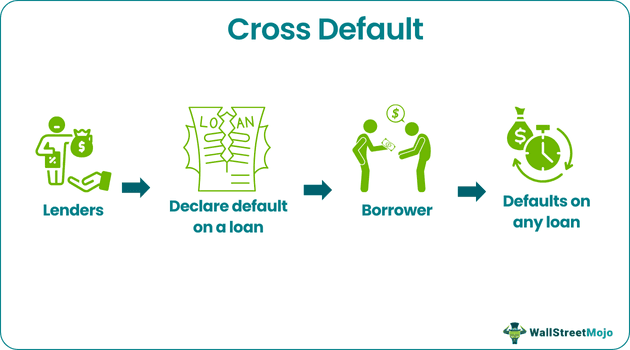Table Of Contents
Cross Default Meaning
A cross-default provision in a contract causes default on one loan if the borrower defaults on another loan or obligation. It protects lenders' interests while ensuring borrowers meet their financial obligations. Hence, the lender can monitor the borrower's financial health and take steps to protect their investments.

With this clause, lenders can mitigate their risk of loss by having the means to enforce the terms of the loan agreement if the borrower defaults on another debt. This provision is often included in loan agreements, bond indentures, and other financial contracts to protect lenders from potential losses in the event of borrower default.
Key Takeaways
- Cross-default refers to a provision in a loan agreement that allows a lender to declare a default on a borrower’s loan if the borrower defaults on any other loan agreement with different lenders.
- The purpose of a cross-default clause is to protect the lender(s) by ensuring that if one borrower cannot fulfill its obligations, the other borrowers will also be required to default
- Cross-default, cross-acceleration, and cross-collateralization are risk management tools that lenders use to secure their investments and reduce the risk of default.
Cross Default Clause Explained
A cross-default clause is a provision, such as a loan agreement, bond indenture, or another similar instrument, that causes the borrower to default on one loan or obligation if the borrower defaults on another. As a result, this clause is included to protect the lenders. Hence, by providing a mechanism to enforce the loan agreement's terms if the borrower defaults on another debt. However, from the borrower's standpoint, this clause can raise borrowing costs by limiting their ability to negotiate more favorable loan terms.
When a borrower defaults on a loan or obligation covered by a cross-default clause, the lender can accelerate debt repayment and take other actions, such as demanding an immediate refund or filing legal action, to enforce the loan agreement's terms. Hence, this can have severe consequences for the borrower, including bankruptcy. As such, this clause specifies any notice obligations the borrower must meet in case of a default. For example, after a default occurs, the borrower is required to notify the lender within a specific timeframe.
Cross-default provisions are commonly found in financial contracts, real estate financing agreements, project finance agreements, and equipment lease agreements. Furthermore, if the borrowers violate a cross-default agreement, the lender may take the following actions:
- Payment acceleration
- Security Enforcement
- Loan agreement termination
- Legal action
Further, in a cross-default swap, one party (the protection buyer) pays a premium to the other party (the protection seller) in exchange for protection against the risk of reference obligation default. Also, this default swap provides critical benefits to both parties. In addition, the lender may require the borrower to provide information about their outstanding debt, interest rates, and repayment terms in a cross-default loan contract.
Examples
Let us look at the examples to understand the concept better.
Example #1
Suppose a manufacturing company takes out multiple loans from different lenders to finance its operations. In each loan agreement, the company agrees to a cross-default provision, which states that if the company defaults on any of the loans, all will be considered in default.
Let's say the company misses a payment on one of its loans. The lender of that loan can trigger this clause and declare all of the company's loans in default. Therefore, this would give the other lenders the right to accelerate the payment of their loans and demand immediate repayment.
In this scenario, the company would face significant financial consequences as it would need to repay all its loans simultaneously. The company may also be forced into bankruptcy due to its inability to meet its debt obligations.
Example #2
A cross-default scenario can be seen in the case of the 2008 financial crisis when many financial institutions were interconnected through complex financial instruments such as mortgage-backed securities When the housing market collapsed, many borrowers defaulted on their mortgages, leading to significant losses for the financial institutions that held these mortgage-backed securities. These losses triggered the clause in the contracts of other financial instruments, such as derivatives and other securities tied to mortgage-backed securities.
As a result, many financial institutions faced demands for immediate repayment of their debt obligations, leading to a financial crisis that ultimately required government intervention to stabilize the financial system. Therefore, this real-life example shows cross-default clauses' impact on financial markets and the broader economy.
Cross Default vs Cross Acceleration vs Cross Collateralization
Cross default, cross acceleration, and cross collateralization are all provisions in financial contracts to protect the lender's interests and ensure timely debt payment in the event of borrower default. Let us look at the below comparison to understand the concept better.
| Clause | Meaning | Trigger Event | Effect |
|---|---|---|---|
| Cross Default | It refers to a provision in a contract that triggers default on one loan or obligation if the borrower defaults on a different loan or obligation. | Default on another loan agreement | Resulting in the acceleration of the loan and the requirement of immediate repayment of the outstanding balance and interest owed. |
| Cross Acceleration | Allows the lender to accelerate the repayment of a loan If the borrower defaults on any other loan agreement with other lenders | Default on another loan agreement | These affect the acceleration of the loan and the requirement of immediate repayment of the outstanding balance and interest owed. |
| Cross Collateralization | This agreement allows the lender to use collateral pledged for one loan to secure other loans made to the borrower. | Default on any loan agreement | It results in the lender seizing the collateral and applying it toward the outstanding balance of any loan in default. |
